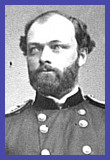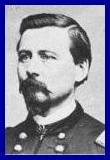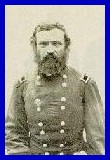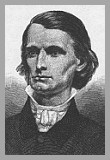| Although
thwarted in his attempt to invest Richmond from the
south, Butler did not intend to lie meekly within his
lines at Bermuda Hundred. However, Grant's decision on
May 25 to detach some 16,000 of Butler's troops to join
the Army of the Potomac at Cold Harbor forced Butler to
remain almost entirely on the defensive, as he had barely
enough troops (10,000 or so) to hold his lines at Bermuda
Hundred and City Point. Although too weak to undertake a major effort, Butler believed that he had enough men on hand to launch a raid on Petersburg, with the objective of destroying the railroad bridge over the Appomattox River. This would effectively sever Richmond's rail connections with the rest of the Confederacy, except for the single line of the Richmond and Danville Railroad. Butler initially planned to have the expedition led by Brig. Gen. Edward Hincks, commander of 3/XVIII, a division of USCT regiments deployed at City Point and Fort Powhatan. Hincks would furnish one infantry brigade, which would be joined by another one from the Bermuda Hundred lines, under the command of Col. Joseph Hawley of the 7th Connecticut, as well as Brig. Gen. A.V. Kautz's small cavalry division. The infantry would advance against Petersburg at two points, forcing the Confederates to commit all of their available force to stop the Yankees. Kautz would then take his troopers on a swing around the Confederate lines and enter Petersburg from the south, along the Jerusalem Plank Road. The total Federal force would be about 3,500 infantry and 1,400 cavalry. To oppose this force the Confederates had a motley crew of units; the 46th Virginia, one company of the 23rd South Carolina, a single cavalry regiment, a single field artillery battery, three collections of local militia, and the heavy guns of the Dimmock Line, Petersburg's permanent defense line. All this would be under the command of Brig. Gen. Henry Wise, former governor of Virginia and fervent secessionist, who commanded the First Military District of the Confederate Department of North Carolina and Southern Virginia. Wise's total strength was about 1,200 men. At the last minute before the expedition set out, Maj. Gen. Quincy Gillmore approached Butler and asked to command it. Butler had no faith in Gillmore, and in fact had worked behind the scenes to block Gillmore's confirmation as major general. But some of the troops to be used in the expedition were from Gillmore's command, and he was the senior field officer, and so Butler, to his eventual regret, agreed to the change. The Federal force began moving on the night of June 8 - 9, and almost immediately there were delays and confusion. By 3:00 a.m. they were finally across the Appomattox River; Hincks's brigade advanced along the Jordan Point Road while Hawley's brigade, accompanied by Gillmore, advanced along the City Point Road; meanwhile, Kautz swung his troopers to the south. At about 7:00 a.m., Hawley's force began to encounter Confederate skirmishers in their front. Confederate reaction to the Federal advance had been swift. The alarm bells rang in Petersburg, calling all the able-bodied men of the city out to join the militia units encamped on Timothy Rives's farm at Battery 27, where the Jerusalem Plank Road passed through the Dimmock Line. These three battalions had been called into the field when Butler's army first appeared at Bermuda Hundred, but in the intervening weeks many of the men had been allowed to return to town to attend to their professional or business affairs. The Petersburg City Battalion, also styled as the 44th Virginia Battalion, was commanded by Maj. Peter V. Batte; two other battalions, commanded by Maj. William Hood and Maj. Fletcher Archer, were formed from men who had come forward to defend the city in early May. As soon as the approach of the Federals was discovered, Batte's and Hood's battalions were sent to support the 46th Virginia in the Dimmock Line. By mid-morning Hawley and Hincks had deployed their two columns in front of the Dimmock Line. Hawley confronted Batteries 1 - 5, and Hincks was in front of Batteries 7 - 13. While the fortifications were imposing, they were barely manned: Hawley had about 250 militia from Hood's and Batte's battalions, plus 150 dismounted cavalry in his front, while Hincks had perhaps 500 men from the 46th Virginia in his front. The tactical problem confronting both Federal commanders was compounded by a projecting salient in the Dimmock Line around Batteries 5-7. This salient enfiladed Hawley's left flank and Hinck's right flank at the same time, making any advance by either Federal column difficult. Although the Federal infantry advance was stymied, this was not really an unfortunate development. Butler's plan had been to threaten Petersburg with two columns so that the third, Kautz's cavalry, could enter the city and destroy the railroad bridge. The advance of Gillmore's infantry had drawn almost all of the Petersburg defenders to the eastern side of the Dimmock Line. Only Maj. Fletcher Archer's militia battalion remained free to oppose Kautz's troopers. And so long as Hawley and Hincks maintained a threatening posture in front of the Dimmock Line the Confederates could not detach anyone to help Archer. Butler's plan was actually working to near perfection. Things were about to change, however. Even though Butler had told him that 1,000 casualties would be a small price to pay for the success of the expedition, Quincy Gillmore refused to press against the Dimmock Line. Butler had told him that the Petersburg garrison was weak, but Gillmore refused to accept this intelligence in the face of the earthworks and artillery in front of his force. Kautz had expected to make his attack at about 9:00 a.m., but Gillmore had heard nothing from the cavalry force, although distant firing from the southwest began to be heard at about 11:30. Sometime around noon, Gillmore issued orders for the infantry to withdraw. His total casualties were sixteen men. Butler's plan placed Kautz's cavalry division on a collision course with Maj. Fletcher Archer's small battalion of reserve militia. Kautz had left Hincks's infantry in the early morning hours to swing southward and then westward until he reached the Jerusalem Plank Road, the avenue along which he was to enter Petersburg. The detour had taken longer than Kautz planned, which is why Gillmore had not heard from him as early as expected. Thus it was at about 11:30 that the column began to draw up in front of the Dimmock Line at Battery 27. Archer's force consisted of approximately 125 men armed with cast-off weapons, supported by a single piece of artillery. So long as Hawley and Hincks confronted Wise's main force along the City Point and Jordan's Point Roads, the Confederates could not detach any force to help the reserves. In response to Wise's pleas for help, Gen. P.G.T. Beauregard was sending a single cavalry regiment, the 4th North Carolina, and an artillery battery, but they had not yet arrived. Archer was on his own. Although the militia repulsed an impetuous mounted charge by a squadron of the 11th Pennsylvania Cavalry, they clearly were not going to be able to hold off 1,300 Federal cavalry. Still, it was their city they were defending, and they intended to do the job as best they could. Brig. Gen. Raleigh Colston, an unassigned Confederate officer, showed up to assist in the defense. A courier was sent to Wise asking for help. Meanwhile Kautz deployed his four regiments to flank Archer's position. The Federal advance was slow but steady. Eventually Archer's left was turned and some of Kautz's men actually took position behind the militia. Although every minute that the militia stood increased the chance of reinforcements appearing, Colston and Archer both decided it was time to retreat, and gave orders for the men to fall back. The fight was over by 1:15, according to the watch carried by one of the Federal officers. Approximately half of the militia force had been killed, wounded, or captured. Kautz ordered the 11th Pennsylvania to advance into town. Part of the regiment entered the city along New Road, part continued down the Jerusalem Plank Road. The advance along New Road was checked at the very edge of town by the timely arrival of the 4th North Carolina Cavalry and the four guns of the Petersburg Artillery, both of which had been sent by Beauregard in response to Wise's cries for help. The other column, advancing on the Jerusalem Plank Road, was checked near Blandford Church by what became known as the "patients and penitents," a collection of walking wounded from the city's military hospitals and some prisoners from the city jails, bolstered by 3 companies of the 46th Virginia, which Wise had been able to detach from the Dimmock Line once Gillmore had fallen back, as well as a small detachment of cavalry. The sudden appearance of so much Confederate resistance took Kautz by surprise. Having heard nothing from Gillmore's infantry, Kautz concluded (correctly) that he was on his own inside the Confederate lines, and a foolhardy advance could lead to the loss of his entire command. Taking counsel of his fears, Kautz decided to withdraw; by about 3:30 in the afternoon his rear guard had passed beyond the Dimmock Line. Thus ended Butler's expedition to Petersburg. In Petersburg there was much sorrow and rejoicing. Sorrow, at the death of 18 citizens of the city, along with 45 others captured and taken to Federal prison camps; rejoicing, at the near-miraculous deliverance of the city. The view from the Federal side was somewhat different. Both Hincks and Kautz criticized Gillmore for retiring too early, and Butler was furious at his X Corps commander for botching the assignment. Butler had wanted a "quick, decisive push" into the city, and had told Gillmore that 1,000 men would not be too much to pay for success; total Federal casualties had been 52. Gillmore was relieved of his command on June 17. The Federal failure on June 9th had long-term repercussions. Realizing that they had been fortunate that the enemy had not made a more vigorous effort, the Confederates shifted troops to Petersburg. The 46th Virginia was joined by the rest of Wise's Brigade, the 4th North Carolina Cavalry was joined by the rest of Dearing's cavalry brigade, and assorted other formations were added to Wise's command. When the Federals next moved on Petersburg there would be as many as 2,800 men available for defense, almost all of them veteran soldiers. |
|
|||||||
This article was prepared almost entirely from the account given in William G. Robertson's book, The Battle of Old Men and Young Boys, published by H.E. Howard of Lynchburg, VA, in 1989. |
Return
to Siege main page. Return to "Why Petersburg?" page. |











